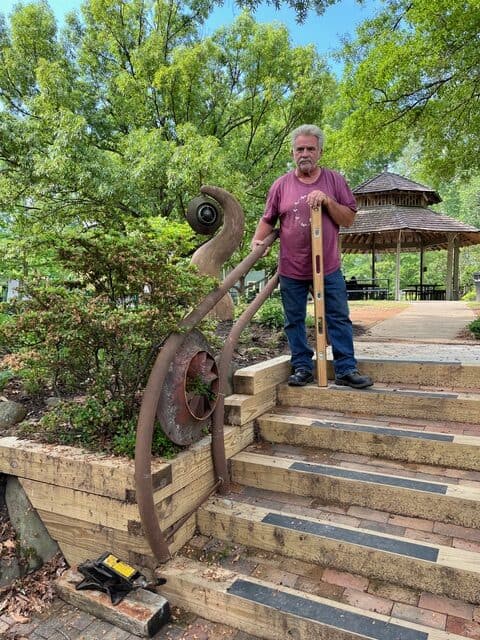The Trinity Park is much more than a playground and place to hold birthday parties and community events. It is a garden and the home of beautiful public art. To truly appreciate how many artists and neighbors worked together to make the newest section of Trinity Park, it helps to know some of the story. It takes a whole community to make the many projects that all work together to form this remarkable space. Come and check out the newest art installation at Trinity Park and appreciate how the many elements work together to complement and enhance each other.
Through our partnership with the Duke Doing Good Housing and Neighborhood program, we have received Neighborhood Grants in both 2024, to redo the dilapidated Eastern most stairs up into the park, and then in 2025 to add railings to increase accessibility. Shelley Dekker, the president of the Trinity Park Foundation, who’s mission includes Community Art, wanted to do railings that were functional art and would complement the Andrew Preiss untitled sculpture in memory of Max Rogers that is located at the top of the new stairs. This sculpture is looking great thanks to the installation of a native plant garden that really complements and makes it more visible. This Native garden was conceived, funded and implemented as a part of Sue Concannon’s Master Naturalist Certification Program through Durham County Cooperative Extension and designed by Rachelle Roake of Reconnect Landscapes in Chapel Hill.
Shelley, an admirer or local artist, Al Frega, hoped he would be willing to create the handrail. Known for his creative use of found materials, Al is the artist behind the amazing railing work at the previous locations of Parker and Otis and Morgan Imports. Unfortunately, Shelly learned Al was retired. However, Trinity Park neighbor and fellow artist David Solow connected Shelley with his longtime friend and Al agreed to take on the project for a price near the DDNP grant amount. Below is Al Frega beside the railing.

The results are spectacular, be sure to check it out and admire the community’s many projects, patrons, and artists that came together to make it happen.
*The Duke-Durham Neighborhood Partnership was created as an office in 1996 to serve as Duke’s first official vehicle for engagement with Durham. Today, the DDNP focuses on a network of 14 partner neighborhoods, gathering and collaborating regularly with neighborhood association leaders based on their collective interests and issues. This network grounds our neighborhood and housing work in the experiences of individual community members and grassroots organizations. Through a consensus process that occurs every 2-3 years, stakeholders within these neighborhoods identify key needs and priorities that guide our work together. Those key needs and priorities are currently as follows: Cultural Heritage & Preservation, Environmental Justice, Housing Justice, Intra-Community Development, Neighborhood Networking, Neighbors Helping Neighbors, Political Activism, Supportive & Safe Communities, and Traffic & Pedestrian Safety. Edited from the DDNP website: https://community.duke.edu/program/duke-durham-neighborhood-partnership/
